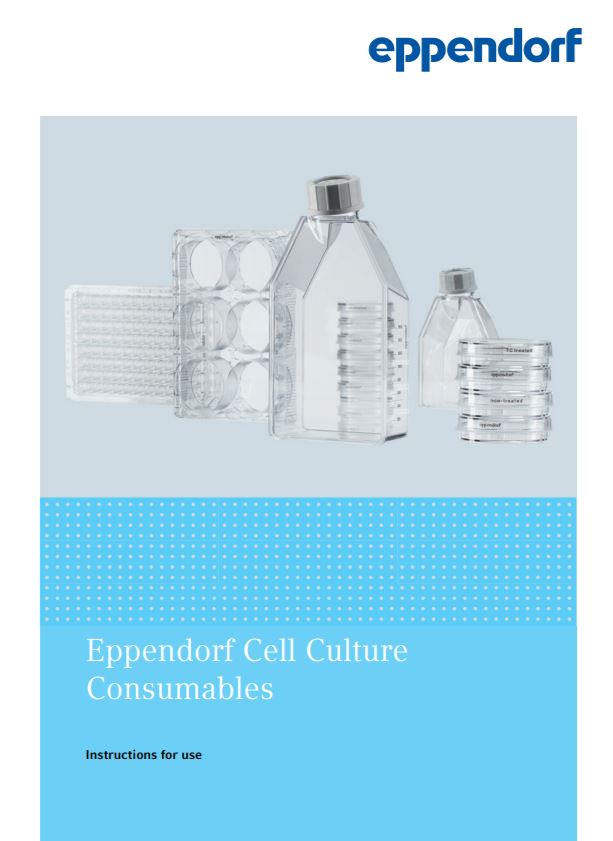Eppendorf Cell Culture Plates
Experience unprecedented convenience and safety for your plate–based cell culture experiments with Eppendorf Cell Culture Plates. Eppendorf Cell Culture Plates are available in 6–well to 96–well formats with TC treated or non–treated surfaces.
Eppendorf Cell Culture Plates Product Description
Experience unprecedented convenience and safety for your plate–based cell culture experiments with Eppendorf Cell Culture Plates. Eppendorf Cell Culture Plates are available in 6–well to 96–well formats with TC treated or non–treated surfaces.
Eppendorf Cell Culture Plates
Experience unprecedented convenience and safety for your plate based cell culture experiments with Eppendorf Cell Culture Plates. Eppendorf Cell Culture Plates are available in 6 well to 96 well formats and with TC treated or non–treated surfaces, allowing you to chose the perfect product for your needs.
Eppendorf Cell Culture Plates are tailored for the expansion of smaller cell numbers as well as for cell-based assay applications. Eppendorf has optimized the optical performance of these Eppendorf Cell Culture Plates by enhancing the planarity, material clarity and reduction of the liquid meniscus to facilitate both manual and automated read-out functions. Contrast rich alphanumeric OptiTrack labeling allows for easy orientation and fast identification of individual wells on the plates.
The new chimney-well design of these Eppendorf Cell Culture Plates avoids inhomogeneous growth of cells in the outer ring of wells which reduces the costs and increases the efficiency of your experiments. If you need to place your cells outside of the incubator for longer periods, filling the inter-well spaces of the plate will keep the temperature stable and prevent unwanted temperature shifts. The lid and plate bottom can easily be differentiated providing extra safety in transportation and stacking.
Check out the Manuals / Specifications tab to view the Technical Specifications table for more information on the design and purity information for these Eppendorf Cell Culture Plates.
Eppendorf Cell Culture Plates features and benefits:
- Easy and fast well identification by contrast-rich individual well ID and OptiTrack alphanumeric labeling.
- The moat surrounding the outer wells to prevent the “edge effect” when filled with liquid.
- Chimney-well design enables filling of the inter-well spaces of the plate to level out well-to-well temperature shifts outside the incubator.
- Robust stacking performance by pronounced rims on plate lid and excellent fitting of lid and base when used in stacks.
- Lid taps under the plate for minimized surface contact and therefore reduced risk of contamination.
- Easy differentiation of lid and plate bottom due to a pronounced corrugation and wider sized base.
- Pronounced ventilation gaps for optimized gas and temperature transfer when incubating in stacks.
- Optimized microscopical performance due to enhanced planarity, reduction of meniscus and clarity of the material.
- Popular applications:
- Expansion and culture of adherent and suspension cells on TC treated or on non-treated polystyrene.
- Performance of cell-based assays and microscopic analysis.
Technical Specifications:
|
Spec.
|
Cell Culture Plate, 6-Well | Cell Culture Plate, 12-Well | Cell Culture Plate, 24-Well | Cell Culture Plate, 48-Well | Cell Culture Plate, 96-Well |
| Material | polystyrene | polystyrene | polystyrene | polystyrene | polystyrene |
| Number of wells | 6 wells | 12 wells | 24 wells | 48 wells | 96 wells |
| Packing | 60 plates, individually wrapped | 60 plates, individually wrapped | 60 plates, individually wrapped | 60 plates, individually wrapped | 80 plates, individually wrapped |
| Purity grade(s) | Sterile, pyrogen-, DNase-, RNase-, human and bacterial DNA-free. Non-cytotoxic | Sterile, pyrogen-, DNase-, RNase-, human and bacterial DNA-free. Non-cytotoxic | Sterile, pyrogen-, DNase-, RNase-, human and bacterial DNA-free. Non-cytotoxic | Sterile, pyrogen-, DNase-, RNase-, human and bacterial DNA-free. Non-cytotoxic | Sterile, pyrogen-, DNase-, RNase-, human and bacterial DNA-free. Non-cytotoxic |
| Dimensions (W?×?D?×?H) | 127.8?× 85.5?× 20.0?mm | 127.8?× 85.5?× 20.0?mm | 127.8?× 85.5?× 20.0?mm | 127.8?× 85.5?× 20.0?mm | 127.8?× 85.5?× 14.4?mm |
| Theoretical total volume | 16 mL | 6.8 mL | 3.6 mL | 1.5 mL | 0.4 mL |
| Working volume | 3?–?5 mL | 1?–?2 mL | 0.5?–?1 mL µL | 0.3?–?0.5 mL | 0.1?–?0.2 mL |
| Growth area/well (1) | 940.3 mm² | 391.1 mm² | 208.9 mm² | 85.6 mm² | 37.0 mm² |
| Well diameter | 34.6 mm | 22.4 mm | 16.2 mm | 10.4 mm | 6.8 mm |
| Height with lid | 23.2 mm | 23.2 mm | 23.2 mm | 23.2 mm | 17.6 mm |
| Dimensions | Conforms to ANSI/SBS I | Conforms to ANSI/SBS I | Conforms to ANSI/SBS I | Conforms to ANSI/SBS I | Conforms to ANSI/SBS I to V |
| Centrifugation | Can be centrifuged up to 2500 × g. When stacked (up to 5 for 96-Well plates and up to 4 for all other formats) can be centrifuged up to 300 × g. | Can be centrifuged up to 2500 × g. When stacked (up to 5 for 96-Well plates and up to 4 for all other formats) can be centrifuged up to 300 × g. | Can be centrifuged up to 2500 × g. When stacked (up to 5 for 96-Well plates and up to 4 for all other formats) can be centrifuged up to 300 × g. | Can be centrifuged up to 2500 × g. When stacked (up to 5 for 96-Well plates and up to 4 for all other formats) can be centrifuged up to 300 × g. | Can be centrifuged up to 2500 × g. When stacked (up to 5 for 96-Well plates and up to 4 for all other formats) can be centrifuged up to 300 × g. |
| (1) For the initial seeding of cells, take into account the growth area in order to support optimal cell growth. | |||||



